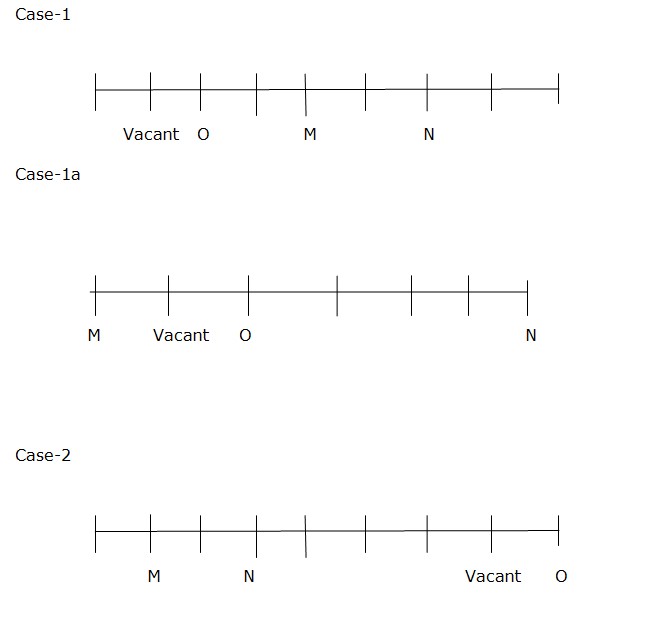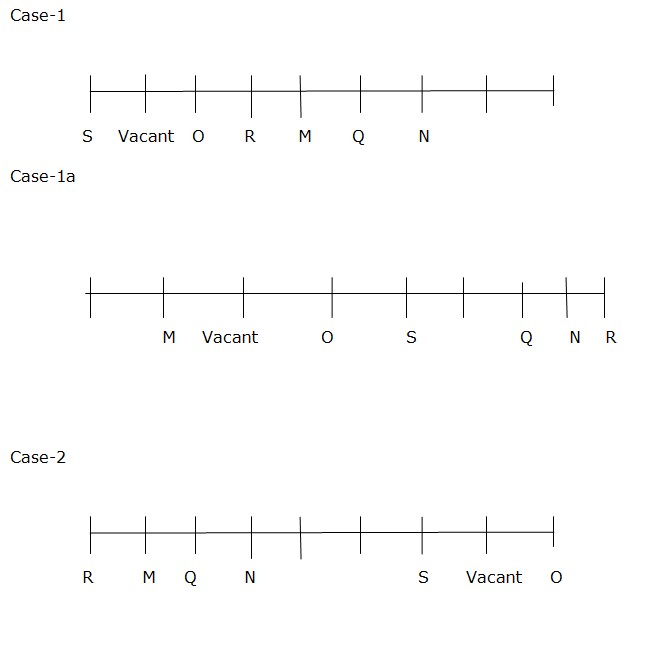Question
Which of the following statement is true?
Study the following information carefully and answer the questions given below. Eight friends – M, N, O, P, Q, R, S, and T, are seating on nine seats in a straight line at an equal distance but not necessarily in the same order. One seat in the row is vacant. All of them are facing north directions. There are three persons sit between O and N. The person who sits two places away from N sits fourth to the right of M. M sits neither adjacent to O nor adjacent to S. The person who sits immediate left of the vacant seat sits two places away from O. Q does not sit adjacent to O. R sits two places away from Q. The number of persons who sits between N and R is one less than the number of persons who sits between S and Q. M does not sit at the end. T sits adjacent to N. The number of persons who sits between Q and P is same as the number of persons who sits between T and O. Q does not sit right of N.Solution
There are three persons sit between O and N. The person who sits two places away from N sits fourth to the right of M. M sits neither adjacent to O nor adjacent to S. The person who sits immediate left of the vacant seat sits two places away from O.  Q does not sit adjacent to O. R sits two places away from Q. The number of persons who sits between N and R is one less than the number of persons who sits between S and Q. M does not sit at the end. Q does not sits right of N.
Q does not sit adjacent to O. R sits two places away from Q. The number of persons who sits between N and R is one less than the number of persons who sits between S and Q. M does not sit at the end. Q does not sits right of N.  T sits adjacent to N. This eliminates case 1a. The number of persons who sits between Q and P is same as the number of persons who sits between T and O. This eliminates case 1 and 1a. so final case-2 Case-2
T sits adjacent to N. This eliminates case 1a. The number of persons who sits between Q and P is same as the number of persons who sits between T and O. This eliminates case 1 and 1a. so final case-2 Case-2 
The ratio of the C.P. and S.P. of an article is 15: 14. What is the Loss percent?
By selling a pair of shoes for Rs.840, the gain is 20%. If the gain is reduced to 15%, find the resultant selling price (in Rs.).
Ranvir bought a car with a 50% discount on the Cost price of the car. Had he got 60% discount, he would have saved Rs 100000. Calculate the Cost price o...
Ravi purchases two wrist watches for a total of Rs. 600. He sells one watch at 4/5 of its cost price and the other at 6/5 of its cost price, and makes a...
- A merchant buys 10 kg of wheat at Rs. 300 per kg. While selling, he uses a faulty weight that shows 1100 grams instead of 1000 grams but claims to sell it ...
The marked price of a chair is Rs. 600. If the chair is sold after allowing successive discounts of 15% and 25%, then find the se...
Zara purchased a microwave for Rs. 2400 and spent some amount on service. She marked it up by 25%, gave a Rs. 360 discount, and earned a 15% profit. Fin...
A shopkeeper claims to incur a loss of 20% but uses a weight of 640 grams in place of 1kg If the CP of the rice is Rs 80/kg , what will be the % of a...
The ratio of difference between the present age of A and B to the present age of B and C is 6:1. 6 years hence, the ratio between the age of A and C is ...
A shopkeeper sells an article with two consecutive discounts of 10% and 20%, respectively, on a marked price of Rs. 1200. If the cost price of the artic...
Relevant for Exams:


